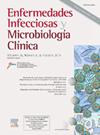Surveillance of MRSA, ESBL-producing Klebsiella pneumoniae, carbapenem-resistant Enterobacteriaceae, and Clostridioides difficile in Catalan Hospitals: Findings from the VINCat Program
IF 2.5
4区 医学
Q3 INFECTIOUS DISEASES
Enfermedades infecciosas y microbiologia clinica
Pub Date : 2025-03-08
DOI:10.1016/j.eimc.2025.02.005
引用次数: 0
Abstract
Introduction
This study aimed to describe the epidemiological trends of methicillin-resistant Staphylococcus aureus (MRSA), extended-spectrum beta-lactamase (ESBL)-producing Klebsiella pneumoniae, carbapenem-resistant Enterobacteriaceae (CRE), and Clostridioides difficile in Catalonia, Spain.
Methods
We analyzed data from hospitals participating in the VINCat Program from 2008 to 2022. The study analyzed antimicrobial susceptibility data from isolates collected in acute care hospital settings. Key metrics: annual MRSA rate, incidence density of new MRSA cases, MRSA bacteremia, and hospital-acquired MRSA cases. We assessed the rate of ESBL-producing K. pneumoniae and carbapenemase-resistant (CR)-K. pneumoniae, CR-Enterobacter cloacae, and CR-Escherichia coli. For C. difficile infections (CDI), the incidence density was determined.
Results
While MRSA rate slightly decreased over the study period, the incidence of MRSA bacteremia increased. Global hospital-acquired MRSA incidence decreased but increased in small hospitals. Among patients with bacteremia, the rate of ESBL-producing K. pneumoniae remained stable; in contrast, the rate of CR-K. pneumoniae rose in large centers as well as did the rates of CR-E. cloacae and CR-E. coli. CDI incidence rose substantially over the study period.
Conclusion
VINCat's hospital surveillance system has provided valuable insights into the evolving incidence of key multidrug-resistant organisms and CDI. These findings highlight the need for targeted interventions, particularly for MRSA in smaller hospitals and for CR-Enterobacteriaceae and CDI across all hospital sizes.
加泰罗尼亚医院MRSA、产esbl肺炎克雷伯菌、耐碳青霉烯肠杆菌科和艰难梭菌的监测:来自VINCat项目的发现
本研究旨在描述西班牙加泰罗尼亚耐甲氧西林金黄色葡萄球菌(MRSA)、产生广谱β -内酰胺酶(ESBL)的肺炎克雷伯菌、耐碳青霉烯肠杆菌科(CRE)和艰难梭菌的流行病学趋势。方法对2008 - 2022年参与VINCat项目的医院数据进行分析。该研究分析了在急症护理医院环境中收集的分离株的抗菌药物敏感性数据。关键指标:年MRSA发病率、新发MRSA病例的发病率密度、MRSA菌血症和医院获得性MRSA病例。我们评估了产esbl肺炎克雷伯菌和碳青霉烯酶耐药(CR)-K的比例。肺炎、cr -阴沟肠杆菌和cr -大肠杆菌。测定艰难梭菌感染(CDI)的发病密度。结果研究期间MRSA发生率略有下降,但MRSA菌血症发生率上升。全球医院获得性MRSA发病率下降,但在小型医院有所上升。在菌血症患者中,产esbl肺炎克雷伯菌的比例保持稳定;相反,CR-K的速率。在大型中心,肺炎的发病率上升,CR-E的发病率也上升。泄殖腔和CR-E。杆菌。CDI发病率在研究期间显著上升。结论vincat的医院监测系统为了解关键多重耐药菌和CDI的发病率演变提供了有价值的见解。这些发现强调了有针对性干预的必要性,特别是针对小型医院的MRSA以及所有医院规模的cr -肠杆菌科和CDI。
本文章由计算机程序翻译,如有差异,请以英文原文为准。
求助全文
约1分钟内获得全文
求助全文
来源期刊
CiteScore
2.10
自引率
8.00%
发文量
194
审稿时长
29 days
期刊介绍:
Hoy está universalmente reconocida la renovada y creciente importancia de la patología infecciosa: aparición de nuevos agentes patógenos, de cepas resistentes, de procesos con expresión clínica hasta ahora desconocida, de cuadros de una gran complejidad. Paralelamente, la Microbiología y la Infectología Clínicas han experimentado un gran desarrollo como respuesta al reto planteado por la actual patología infecciosa. Enfermedades Infecciosas y Microbiología Clínica es la Publicación Oficial de la Sociedad Española SEIMC. Cumple con la garantía científica de esta Sociedad, la doble función de difundir trabajos de investigación, tanto clínicos como microbiológicos, referidos a la patología infecciosa, y contribuye a la formación continuada de los interesados en aquella patología mediante artículos orientados a ese fin y elaborados por autores de la mayor calificación invitados por la revista.

 求助内容:
求助内容: 应助结果提醒方式:
应助结果提醒方式:


